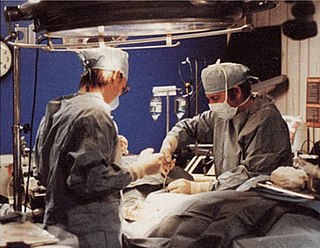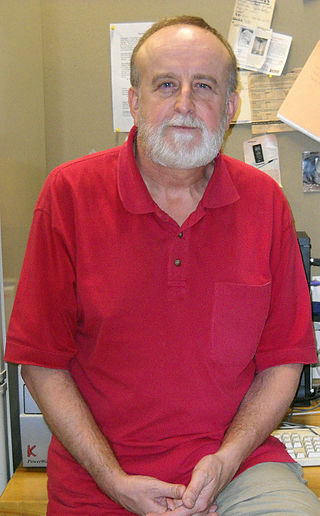Related Research Articles

Cryonics is the low-temperature freezing and storage of human remains, with the speculative hope that resurrection may be possible in the future. Cryonics is regarded with skepticism within the mainstream scientific community. It is generally viewed as a pseudoscience, and its practice has been characterized as quackery.

Freezing is a phase transition where a liquid turns into a solid when its temperature is lowered below its freezing point. In accordance with the internationally established definition, freezing means the solidification phase change of a liquid or the liquid content of a substance, usually due to cooling.
Cryobiology is the branch of biology that studies the effects of low temperatures on living things within Earth's cryosphere or in science. The word cryobiology is derived from the Greek words κρῧος [kryos], "cold", βίος [bios], "life", and λόγος [logos], "word". In practice, cryobiology is the study of biological material or systems at temperatures below normal. Materials or systems studied may include proteins, cells, tissues, organs, or whole organisms. Temperatures may range from moderately hypothermic conditions to cryogenic temperatures.

Supercooling, also known as undercooling, is the process of lowering the temperature of a liquid below its freezing point without it becoming a solid. As per the established international definition, supercooling means ‘cooling a substance below the normal freezing point without solidification’ While it can be achieved by different physical means, the postponed solidification is most often due to the absence of seed crystals or nucli around which a crystal structure can form. The supercooling of water can be achieved without any special techniques other than chemical demineralization, down to −48.3 °C (−54.9 °F). Supercooled water can occur naturally, for example in the atmosphere, animals or plants.

Liver transplantation or hepatic transplantation is the replacement of a diseased liver with the healthy liver from another person (allograft). Liver transplantation is a treatment option for end-stage liver disease and acute liver failure, although availability of donor organs is a major limitation. The most common technique is orthotopic transplantation, in which the native liver is removed and replaced by the donor organ in the same anatomic position as the original liver. The surgical procedure is complex, requiring careful harvest of the donor organ and meticulous implantation into the recipient. Liver transplantation is highly regulated, and only performed at designated transplant medical centers by highly trained transplant physicians and supporting medical team. Favorable outcomes require careful screening for eligible recipients, as well as a well-calibrated live or deceased donor match.
21st Century Medicine (21CM) is a California cryobiological research company which has as its primary focus the development of perfusates and protocols for viable long-term cryopreservation of human organs, tissues and cells at temperatures below −100 °C through the use of vitrification. 21CM was founded in 1993.
A cryoprotectant is a substance used to protect biological tissue from freezing damage. Arctic and Antarctic insects, fish and amphibians create cryoprotectants in their bodies to minimize freezing damage during cold winter periods. Cryoprotectants are also used to preserve living materials in the study of biology and to preserve food products.
Machine perfusion (MP) is a technique used in organ transplantation as a means of preserving the organs which are to be transplanted.
Gregory M. Fahy is a California-based cryobiologist, biogerontologist, and businessman. He is Vice President and Chief Scientific Officer at Twenty-First Century Medicine, Inc, and has co-founded Intervene Immune, a company developing clinical methods to reverse immune system aging. He is the 2022–2023 president of the Society for Cryobiology.
The Organ Care System (OCS) is a medical device designed by Transmedics to allow donor organs to be maintained for longer periods of time prior to transplant. The system mimics the elements of human physiology and keeps organs in an environment and temperature similar to the human body. The system allows for organ preservation that last longer than the standard organ preservation method of putting organs on ice, static cold storage, which can cause cold ischemia. When put on ice, organs begin to deteriorate about three to four hours after retrieval. On the other hand, the Paragonix SherpaPak Cardiac Transport System can offer uniform cooling by suspending the donor heart in a preservation solution, and provides continuous temperature monitoring.

Oocyte cryopreservation is a procedure to preserve a woman's eggs (oocytes). This technique has been used to postpone pregnancy. When pregnancy is desired, the eggs can be thawed, fertilized, and transferred to the uterus as embryos. Several studies have shown that most infertility problems are due to germ cell deterioration related to aging. The procedure's success rate varies depending on the age of the woman,, as well as depending on health and genetic indicators. In 1986, the first human birth of oocyte oocyte cryopreservation was reported.

The Methuselah Foundation is an American-based global non-profit organization based in Springfield, Virginia, with a declared mission to "make 90 the new 50 by 2030" by supporting tissue engineering and regenerative medicine therapies. The organization was originally incorporated by David Gobel in 2001 as the Performance Prize Society, a name inspired by the British governments Longitude Act, which offered monetary rewards for anyone who could devise a portable, practical solution for determining a ship's longitude.

Cryopreservation or cryoconservation is a process where biological material - cells, tissues, or organs - are frozen to preserve the material for an extended period of time. At low temperatures any cell metabolism which might cause damage to the biological material in question is effectively stopped. Cryopreservation is an effective way to transport biological samples over long distances, store samples for prolonged periods of time, and create a bank of samples for users. Molecules, referred to as cryoprotective agents (CPAs), are added to reduce the osmotic shock and physical stresses cells undergo in the freezing process. Some cryoprotective agents used in research are inspired by plants and animals in nature that have unique cold tolerance to survive harsh winters, including: trees, wood frogs, and tardigrades.The first human corpse to be frozen with the hope of future resurrection was James Bedford's, a few hours after his cancer-caused death in 1967.[15] Bedford's is the only cryonics corpse frozen before 1974 still frozen today.

Kenneth B. Storey is a Canadian scientist whose work draws from a variety of fields including biochemistry and molecular biology. He is a Professor of Biology, Biochemistry and Chemistry at Carleton University in Ottawa, Canada. Storey has a world-wide reputation for his research on biochemical adaptation - the molecular mechanisms that allow animals to adapt to and endure severe environmental stresses such as deep cold, oxygen deprivation, and desiccation.
Semen cryopreservation is a procedure to preserve sperm cells. Semen can be used successfully indefinitely after cryopreservation. It can be used for sperm donation where the recipient wants the treatment in a different time or place, or as a means of preserving fertility for men undergoing vasectomy or treatments that may compromise their fertility, such as chemotherapy, radiation therapy or surgery. It is also often used by trans women prior to medically transitioning in ways that affect fertility, such as feminizing hormone therapy and orchiectomies.
Korkut Uygun is a Turkish chemical engineer and a medical researcher.

A viability assay is an assay that is created to determine the ability of organs, cells or tissues to maintain or recover a state of survival. Viability can be distinguished from the all-or-nothing states of life and death by the use of a quantifiable index that ranges between the integers of 0 and 1 or, if more easily understood, the range of 0% and 100%. Viability can be observed through the physical properties of cells, tissues, and organs. Some of these include mechanical activity, motility, such as with spermatozoa and granulocytes, the contraction of muscle tissue or cells, mitotic activity in cellular functions, and more. Viability assays provide a more precise basis for measurement of an organism's level of vitality.
Isolated organ perfusion technique is employed to precipitate an organ's perfusion and circulation that are independent/isolated from the body's systemic circulation for various purposes such as organ-localized chemotherapy, organ-targeted delivery of drug, gene or anything else, organ transplantation, and organ injury recovery. The technique has been widely studied in animal and human for decades. Before the implementation, the perfusion system will be selected and the process can be similar to organ bath. Isolated organ perfusion technique, nevertheless, is averagely conducted in vivo without leaving the organ alone as a whole out of the body.
Plant cryopreservation is a genetic resource conservation strategy that allows plant material, such as seeds, pollen, shoot tips or dormant buds to be stored indefinitely in liquid nitrogen. After thawing, these genetic resources can be regenerated into plants and used on the field. While this cryopreservation conservation strategy can be used on all plants, it is often only used under certain circumstances: 1) crops with recalcitrant seeds e.g. avocado, coconut 2) seedless crops such as cultivated banana and plantains or 3) crops that are clonally propagated such as cassava, sweet potato.
Aldehyde-stabilized cryopreservation is a new technique for cryopreservation first demonstrated in 2016 by Robert L. McIntyre and Gregory Fahy at the cryobiology research company 21st Century Medicine, Inc. This technique uses a particular implementation of fixation and vitrification that can successfully preserve a rabbit brain in "near perfect" condition at −135 °C, with the cell membranes, synapses, and intracellular structures intact in electron micrographs. The technique has finally won the Small Animal Brain Preservation Prize of the Brain Preservation Foundation. The cryopreserved brain was rewarmed and no serious degradation was found to have occurred; the brain structure under electron microscopic evaluation after rewarming remained well-preserved. Although this technique has not yet lead to a successful revival of a cryopreserved brain, some researchers see this technique as providing promising directions for future research.
References
- ↑ Kelly, Tim (June 2, 2008). "Mr. Freeze—Norio Owada's freezing method can keep milk fresh for months. Livers, too". Forbes. Retrieved September 21, 2012.
- ↑ Owada, N. (2009) "Quick Freezing Apparatus and Quick Freezing Method" US Patent Application
- ↑ Owada, N. (2002) "Highly-efficient freezing apparatus and highly-efficient freezing method" US Patent 7,237,400
- ↑ Wowk, B (Jun 2012). "Electric and magnetic fields in cryopreservation". Cryobiology. 64 (3): 301–3, author reply 304–5. doi:10.1016/j.cryobiol.2012.02.003. PMID 22330639.
- ↑ Kobayashi, Atsuko; Kirschvink, Joseph L. (2014-04-01). "A ferromagnetic model for the action of electric and magnetic fields in cryopreservation". Cryobiology. 68 (2): 163–165. doi: 10.1016/j.cryobiol.2013.12.002 . ISSN 0011-2240. PMID 24333152.
- ↑ Bruinsma, Bote G.; Uygun, Korkut (June 2017). "Subzero organ preservation: the dawn of a new ice age?". Current Opinion in Organ Transplantation. 22 (3): 281–286. doi:10.1097/MOT.0000000000000403. ISSN 1087-2418. PMC 5520671 . PMID 28266941.
- ↑ Uygun, Korkut; Yarmush, Martin L.; Toner, Mehmet; Izamis, Maria-Louisa; Uygun, Basak E.; Usta, O. Berk; Saeidi, Nima; Puts, Catheleyne F.; Bruinsma, Bote G.; Berendsen, Tim A. (July 2014). "Supercooling enables long-term transplantation survival following 4 days of liver preservation". Nature Medicine. 20 (7): 790–793. doi:10.1038/nm.3588. ISSN 1546-170X. PMC 4141719 . PMID 24973919.
- ↑ Szabó, Gábor (15 September 2012). "Hearts From the Deep Freezer? Novel Concept to Increase Safe Cardiac Preservation Times". Transplantation. 94 (5): 449. doi: 10.1097/TP.0b013e3182637097 . ISSN 0041-1337. PMID 22895610.
- ↑ Cheng, Lina; Sun, Da-Wen; Zhu, Zhiwei; Zhang, Zi (2017). "Emerging techniques for assisting and accelerating food freezing processes: A review of recent research progresses". Critical Reviews in Food Science and Nutrition. 57 (4): 769–781. doi:10.1080/10408398.2015.1004569. PMID 26115177. S2CID 19803416.